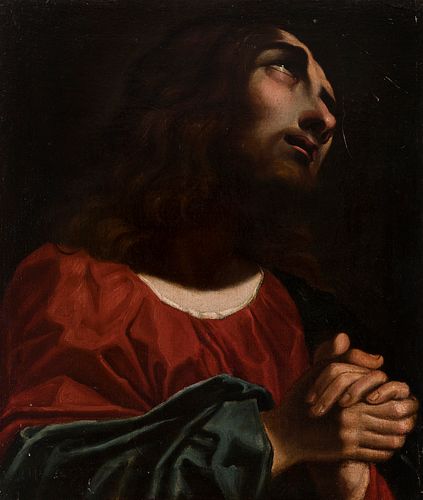Italian school; 17th century. "Christ in prayer". Oil on canvas. Relined.
Lot 31
About Seller
Setdart Auction House
Carrer Aragó 346
Barcelona
Spain
Setdart Subastas was born in 2004 and is currently the first online art auction in Spain with solidity, prestige and reliability guaranteed by our more than 60,000 users. Setdart has a young, dynamic and enterprising team ready to successfully manage the purchase and sale of art works through custom...Read more
Estimate:
EUR€3,000 - EUR€4,000
$3,225.81 - $4,301.08
Absentee vs Live bid
Two ways to bid:
- Leave a max absentee bid and the platform will bid on your behalf up to your maximum bid during the live auction.
- Bid live during the auction and your bids will be submitted real-time to the auctioneer.
Bid Increments
| Price | Bid Increment |
|---|---|
| EUR€0 | EUR€10 |
| EUR€200 | EUR€25 |
| EUR€500 | EUR€50 |
| EUR€1,000 | EUR€100 |
| EUR€3,000 | EUR€200 |
| EUR€5,000 | EUR€500 |
| EUR€10,000 | EUR€1,000 |
| EUR€20,000 | EUR€2,000 |
| EUR€50,000 | EUR€5,000 |
About Auction
By Setdart Auction House
Oct 20, 2021
Set Reminder
2021-10-20 07:30:00
2021-10-20 07:30:00
America/New_York
Bidsquare
Bidsquare : OLD MASTERS
https://www.bidsquare.com/auctions/setdart-auction-house/old-masters-7700
Setdart Auction House sofia@setdart.com
Setdart Auction House sofia@setdart.com
- Lot Description
Italian school; 17th century. "Christ in prayer". Oil on canvas. Relined. It has repainting and slight scratches on the varnish. Size: 52 x 44 cm. In pious attitude with his hands gathered together on his chest, and his gaze raised towards God, the author of this work, presents us with a painting of great religious load, where the protagonism is based on the transmission of Christian values. Bust-length, but slightly turned to the viewer, the figure of Christ is presented in a simple way without any iconographic element that specifies a biblical passage. Only the colors of his tunic and mantle, red in allusion to the passion and blue referring to universality, added to the pious attitude of Jesus, indicate that this is a work that tries to show the suffering of Christ, and his sacrifice for the benefit of humanity. However, the neatness of the gesture and the softness of the brushstrokes, tight and precise, show us a contained work, where only the reddened eyelids of the Lord, point out a dramatic note. The author of this canvas dispenses with any element that could distort the image of Christ and seeks no other theological meaning than that of Christ's own suffering and voluntary sacrifice on behalf of humanity. In fact, this supreme generosity is reinforced by Jesus' own gaze, which avoids ours, turning to one side, towards something that we do not see because it is outside the painting. On the other hand, compositionally everything is designed to enhance the figure of Christ. The figure is worked with an enormous idealism, highlighting the softness of the face, the expressiveness of the hands, and the tenebrist lighting used manages to provide a greater physical presence, a greater three-dimensionality and also intensity and effectiveness to the figure. These features, as well as the chromatic range used, are typical of the Italian baroque. The dramatic figure is silhouetted against a dark background of dense darkness, as if emerging from the shadows, directly illuminated by a theatrical and directed spotlight that enters the image from the upper right corner and falls directly on the face and hands of the Lord.
- Shipping Info
-
In-house shipping available. Please inquire at admin@setdart.com.
-
- Buyer's Premium



 EUR
EUR CAD
CAD AUD
AUD GBP
GBP MXN
MXN HKD
HKD CNY
CNY MYR
MYR SEK
SEK SGD
SGD CHF
CHF THB
THB








